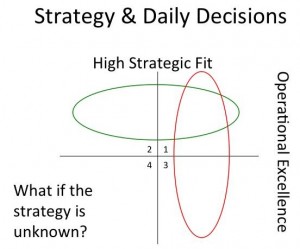The best and most ambitious managers make things happen. I love their enthusiasm and energy. I love their eagerness to learn and improve. I applaud their great plans and accomplishments.
And then I ask about the direction of the organization. Too often it’s like pulling the plug and letting the energy, the momentum, and even the speaking volume rush down the drain. Sometimes hushed tones express concern for the organization’s future. Sometimes embarrassment or lack of confidence permeates a confused answer. Sometimes the eyeballs roll, followed by an explanation of an inept or non-existent strategic process.
These responses are indicative of two possible and extremely common conditions, both of which guarantee your best employees are wasting your resources and, very possibly, looking for a new job.
- There is no clear, viable strategic direction
- Your managers do not understand and accept the strategy and its implications
Why is that such a problem, especially when your top talent is accomplishing so much? The following diagram ought to make that clear:
The green oval represents activities that are highly important to the organization’s strategic direction and creating a prosperous future. The red oval represents activities that will have the greatest positive impact on current operational effectiveness. In very few cases will your future organization need nothing more than a more perfect and/or expanded version of your current operations in order to thrive. How relevant to your future are your current products, current customers, current markets, current employees, current processes, current sales and distribution channels, current facilities, etc.?
In the absence of a strong, believable strategy, ambitious employees have two choices:
1) They can focus on the organization’s current activities and try to make everything better.
These activities fall in the red oval, some in Quadrant #3 and of little or no use to the future organization. For example, I know star employees proud of their success in increasing production capabilities while demand seems to have begun a long downward slide. Others are courting difficult customers in soon-to-be-abandoned markets. The low-hanging fruit (easy, quick-win initiatives) in Quadrant #3 are just as likely to be at the top of their lists as the low-hanging fruit in Quadrant #1!
OR
2) They can look to the future, make their own guesses, and hope they are right.
Will their green oval coincide with yours? Do their peers share their expectations of the future? No and no. In the absence of a clear, believable strategy, Quadrant #2 efforts reflect individual interests, expertise, and pet peeves. Your IT department wants to beef up your technology. Your software engineers are adding cool options to products regardless of customer interest or market stability. Your operations manager is rearranging the entire production floor, ostensibly to increase efficiency, but more importantly, to facilitate an easy transition to the new equipment he is sure will be needed next year.
In both cases, your best, most determined employees are moving forward at full speed, consuming time and money, without the ability to assess strategic fit.
Meanwhile, they are probably also out looking for jobs at companies with a stronger strategic focus, less confusion, and a more promising future!
The cure, of course, is a strong, smart, clear strategic direction understood by all and effective in guiding daily decisions throughout the organization.
Want to know the level of strategic clarity in your company right now? My Clarity Index™ will provide that information. Or maybe you already know you don’t have strategic clarity. In either case, contact me at ann@uncommonclarity.com or 800-527-0087. I can create that clarity in remarkably little time.



Comments are closed.